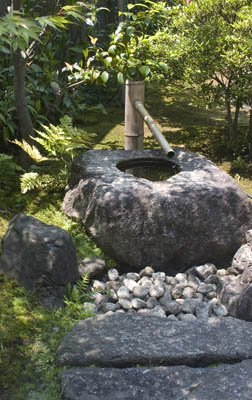There are also several other typical elements of Japanese garden design that have been used by tea masters since the sixteenth century.

One of the main functional purposes of the roji was to prepare the guests for the tea ceremony, which included providing somewhere within the inner roji where they could rinse their hands and mouths as an act of purification before entering the tea hut.
The water basin itself (chōzubachi) will usually be made of stone and set in a circular arrangement of stones on the ground known as a tsukubai (literally ‘squatting’). There will be a bamboo ladle. The basin may be continuously filled from a bamboo spout.
Stone lanterns (ishi-dōrō) are frequently found in roji and come in various shapes and sizes. If there is only one lantern in a roji then it will typically be behind the tsukubai and arranged so that its light falls on the basin.
However, the use of such elements should not be overdone.
start